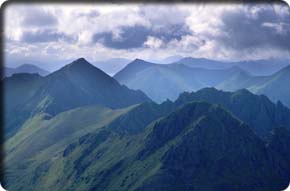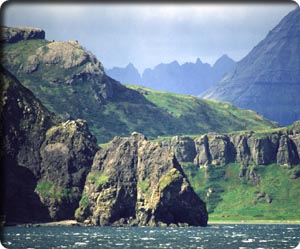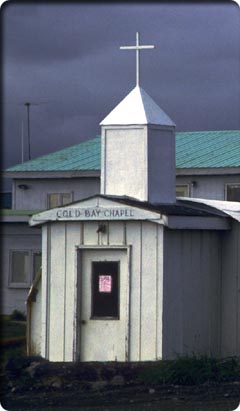| a l a s k a j o u r n e y . c o m |
| Kodiak & the Alaska Peninsula |
|
This magnificent region of rugged isles, wild coastlands, and glacier-capped volcanoes is famous primarily as the home of Alaska’s huge brown bears. The browns are essentially grizzlies living the good life, growing larger than their inland cousins thanks to a steady summer diet of salmon. Though Kodiak Island is home to the largest of them, Katmai National Park is generally a better choice for bear observation. Hunters are allowed an annual quota of Kodiak bears, making the larger population more wary of humans. In the key viewing areas of Katmai and the adjacent McNeil River State Game Sanctuary, bears roam with little or no interest in human observers. Bear-viewing trips are a mainstay of tour-service providers. You can choose from two basic approaches for a short-term, guaranteed look at brown bears. Reservations can be made for one of several destinations with a consistent summer presence of bears. The town of Kodiak serves as the best gateway to Kodiak and Afognak Islands, as well as the south coast of Katmai and the Alaska Peninsula. To the north, Brooks Camp is an excellent base for bear observation, salmon fishing, and hiking access to the Katmai interior, including the Valley of Ten Thousand Smokes. To reach Brooks Camp, most fly from Anchorage to the town of King Salmon, then take a floatplane shuttle to Brooks. Together with nearby Naknek on Bristol Bay, King Salmon represents the largest settlement on the Alaska Peninsula and serves as a gateway to many remote fishing, hunting, and exploration destinations. To the west, the peninsula gradually narrows before coming to an end at False Pass and the beginning of the Aleutian Islands. Throughout the peninsula, the south coast is mountainous and rugged, with steep, battered headlands and ragged bays backed by high ridges and volcanic cones. The north coast is much gentler, featuring thousands of lakes and ponds, sprawling boggy flats, and miles of beaches, bars, and tidal flats. Though the pattern is complicated, native lands are generally on the south coast, state lands on the north, and federal public lands along the peninsula’s mountainous Ferry Access A few times every summer, the A.M.H.S. ferry Tustamena makes a run from Homer to Dutch Harbor–Unalaska and back, stopping at Kodiak and several coastal towns on the Alaska Peninsula and Aleutian Islands. The route is exposed to open ocean at many points so the journey can be rough, but if you’re not daunted by challenges to the stomach, ferry travel in the Southwest offers a fantastic and comparatively inexpensive experience. It is possible to create Southwestern journeys using the ferry for part or all of the transport. Perhaps you fly to Unalaska for an Aleutian trek, then ferry back to Kodiak for a stay before returning to Anchorage. You might take the outbound ferry as far as The towns below are served by the ferry or are useful as bases for exploring designated parks and refuges. For information on other settlements and their utility as bases for exploration, consult the Alaska Department of Community and Regional Affairs, native corporation offices, and park and refuge offices—all listed in the appendix. |

 The best and most popular are Brooks Camp and McNeil River—source of the most famous documentary video images. The second "guaranteed" choice is to take a bear-viewing flight with a flightseeing company that regularly monitors bear activity. Uyak Air and others fly from Kodiak to the hot spots for a couple hours of close-up viewing.
The best and most popular are Brooks Camp and McNeil River—source of the most famous documentary video images. The second "guaranteed" choice is to take a bear-viewing flight with a flightseeing company that regularly monitors bear activity. Uyak Air and others fly from Kodiak to the hot spots for a couple hours of close-up viewing. backbone. Settlement is so limited that it matters little—though if you plan to enter native lands it pays to inquire with native corporation offices about permissions. No permits are required in any of the public lands except McNeil River State Game Sanctuary (see below).
backbone. Settlement is so limited that it matters little—though if you plan to enter native lands it pays to inquire with native corporation offices about permissions. No permits are required in any of the public lands except McNeil River State Game Sanctuary (see below). Cold Bay, enjoying two days of birding in Izembek National Wildlife Refuge before catching the Tustamena in King Cove on its return. The possibilities are many (contact A.M.H.S. for schedules; see the
Cold Bay, enjoying two days of birding in Izembek National Wildlife Refuge before catching the Tustamena in King Cove on its return. The possibilities are many (contact A.M.H.S. for schedules; see the